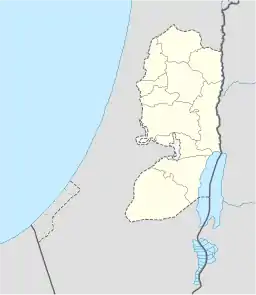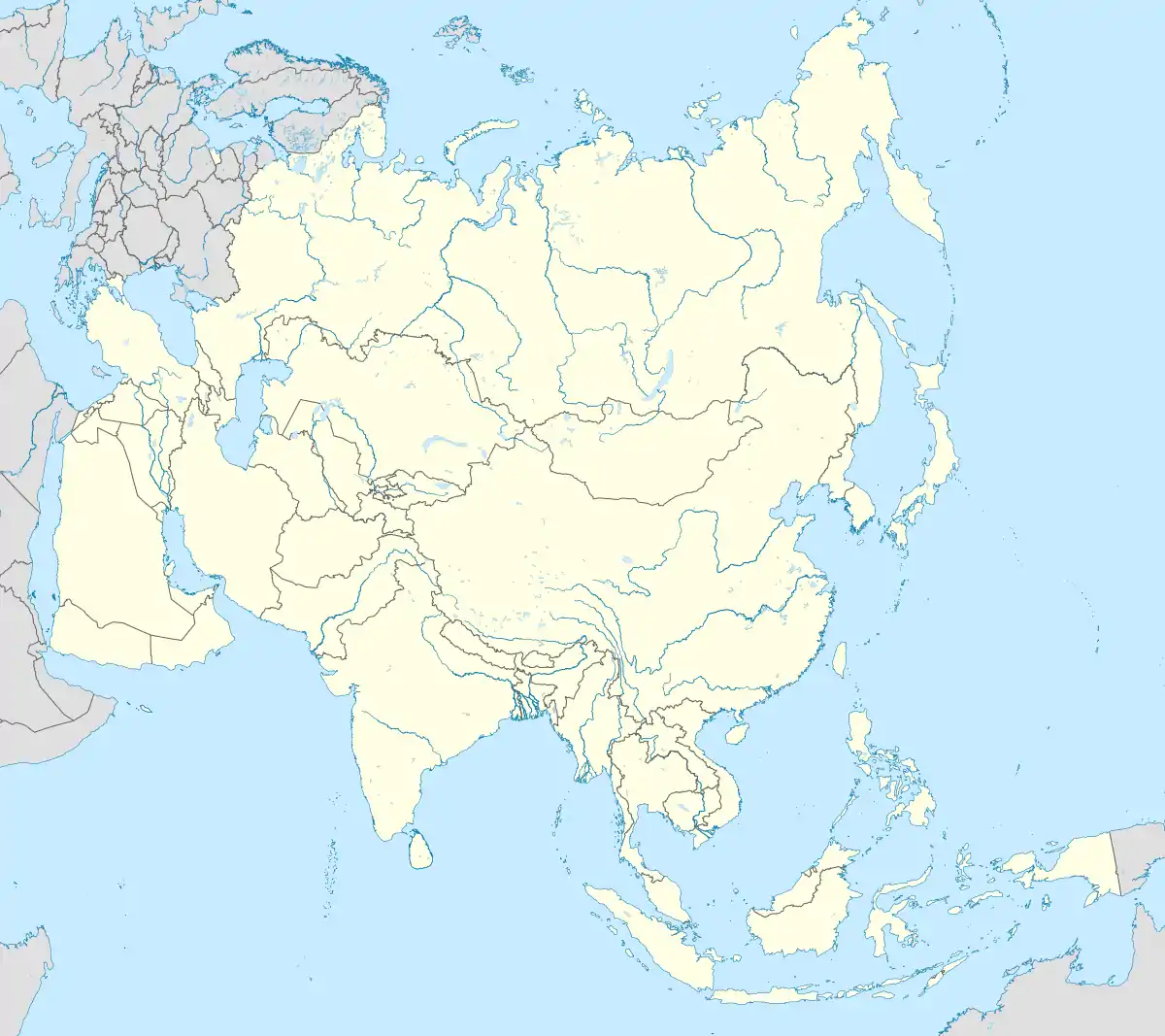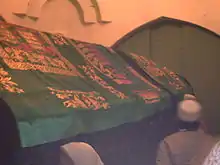Nabi Musa
Nabi Musa (Arabic: ٱلنَّبِي مُوْسَى, romanized: An-Nabī Mūsā, meaning "The Prophet Moses",[2] also transliterated as Nebi Musa) is the name of a site in the West Bank believed to be the tomb of Musa (Moses). It is also the name of a seven-day long religious festival that was celebrated annually by Palestinian Muslims, beginning on the Friday before Good Friday in the old Greek Orthodox calendar.[3] Considered "one of the most important Muslim pilgrimages in Palestine",[4] the festival centered on a collective pilgrimage from Jerusalem to what was understood to be the Tomb of Moses, near Jericho. A great building with multiple domes marks the mausoleum of Moses.[5] A number of 66 Palestinian households has been counted in 2007 at the locality of Nabi Musa, in contrast to three male individuals in 1931.[6][7]
Nabi Musa | |
|---|---|
Local Development Committee | |
| Arabic transcription(s) | |
| • Arabic | ٱلنَّبِي مُوْسَى |
| • Latin | An-Nabi Musa (official) Nebi Musa (unofficial) |
| Hebrew transcription(s) | |
| • Hebrew | נבי מוסא |
 Nabi Musa, 2010 | |
 Nabi Musa Location of Nabi Musa within the West Bank in the State of Palestine  Nabi Musa Nabi Musa (Asia) | |
| Coordinates: 31°47′N 35°26′E | |
| State | State of Israel |
| Governorate | Jericho |
| Government | |
| • Type | Local Development Committee |
| Area | |
| • Total | 122,248[1] dunams (122.2 km2 or 47.2 sq mi) |
| Population (2007) | |
| • Total | 309 |
| • Density | 2.5/km2 (6.5/sq mi) |
| Name meaning | "Prophet Moses" |
Location
The shrine of El-Nabi Musa lies 11 km (6.8 mi) south of Jericho and 20 km (12 mi) east of Jerusalem in the Judean wilderness.[8] A side road to the right of the main Jerusalem-Jericho road, about 2 km (1.2 mi) beyond the sign indicating sea level, leads to the site.
"Tomb of Moses" tradition

The "Tomb of Moses" is located, according to local tradition, at Maqam El-Nabi Musa.[8] The Fatimids, Taiyabi and Dawoodi Bohra sects also believe in this tradition. In contrast, the biblical book of Deuteronomy records that Moses "was buried in a valley in the land of Moab, opposite Beth-peor" (east of the Jordan River) and that "no one knows the place of his burial to this day" (Deut 34:6).
It is not known when this tradition has first emerged.[9] The Jerusalem-Jericho road was one of the primary routes used by Mediterranean Arabs to make a pilgrimage to Mecca. The site where the shrine stands since the 13th century is located at what would be have marked the end of the first day's march in that direction. Originally, it was simply a point from which pilgrims could look across the Jordan Valley and catch a glimpse of Mount Nebo where (as suggested by the Hebrew Bible) the tomb of Moses was thought to be located.[5] According to Uri M. Kupferschmidt, it appears to have become a fixed point in the local Muslim calendar from the time of Saladin.[10]
It seems that by the time that Mamluk sultan Baibars visited the site in 1269 while returning from his hajj, "there must have been some association", since he set about building an extensive shrine.[9] The Arab geographer Muqaddasi from Jerusalem, writing in the 1490s, admits that the tradition has only a weak chance of authenticity, but that Nabi Musa still is the most popular among several sites with similar claims.[9]
History
Mamluk period
In 1269, the Mamluk sultan Baibars al-Bunduqdari built a small shrine there, as part of a general policy he adopted after conquering towns and rural areas from Lebanon down to Hebron from the Crusaders. The shrines were mostly dedicated to biblical prophets and the companions of Mohammed, and their maintenance was funded by an waqf, an endowment from properties that formerly belonged to the Latin Church. In the case of Nabi Musa, the waqf fund was secured from ecclesiastical assets expropriated in nearby Jericho.[11]
Baibars al-Bunduqdari's constructive piety set a precedent for others. Over the late medieval period, hostels for travellers were built on adjacent to the shrine, and the hospice in its present form was completed in the decade between 1470 and 1480. Gradually, the lookout point for Moses' distant gravesite beyond the Jordan was confused with Moses' tomb itself, laying the ground for the cultic importance Nabi Musa was to acquire in the Sunni Arab reverence of saints (walis).
Ottoman period
Around 1820, the Ottoman authorities restored the buildings, which had, over the previous centuries, fallen into a state of dilapidated disrepair. In addition, they promoted a festive pilgrimage to the shrine that would always coincide with the Christian celebration of Easter, giving Muslims a way to celebrate during the time that their Christian neighbours were celebrating. This 'invention of tradition', as such imaginative constructs are called,[12] made the pageantry of the Nabi Musa pilgrimage a potent symbol of both political and religious identity among Muslims from the outset of the modern period.[5][13]
Over the 19th century, thousands of Muslims would assemble in Jerusalem, trek to Nabi Musa, and pass three days in feasting, prayer, games and visits to the large tomb two kilometres south, identified as that of Moses' shepherd, Hasan er-Rai, They were then entertained, as guests of the waqf, before returning on the seventh day triumphantly back to Jerusalem.[5]
In the late 19th century, the Ottomans appointed the al-Husayni clan as official custodians of the shrine and hosts of the festival, though their connection with the cult may date back to the previous century. According to Yehoshua Ben-Aryeh, the governor of Jerusalem Rauf Pasha (1876–1888), was the first to attempt to exploit the festival to incite Muslims against Christians. Ilan Pappé offers a different view:
'It is more likely, however, that the governor and his government were rather apprehensive of such an anti-Christian uprising as it could stir instability and disorder at a time when the central government was trying to pacify the Empire. This had been indeed the impression of the engineer (seconded to the Palestine Exploration Fund) Claude Conder. The Hebrew paper, Ha-havazelet, at the time blessed the Ottoman government for imposing law and order in the Nabi Musa affair. The travelogues of Francis Newton testify as well to a peaceful execution of the ceremonies. Indeed, the Turkish government must have acted here against popular feelings, shared by the Husaynis as the masters of the ceremony that Nabi Musa was celebrated in the most unfavourable conditions for the Muslims. It was the iron fist imposed by the Turks that prevented the situation from deteriorating into an all out riot.'[14]


The procession moved off from Jerusalem under a distinctive Nabi Musa banner which the Husaynis conserved for the annual occasion in their Dar al-Kabira. On arriving at the shrine, the al-Husaynis and another rising Jerusalem family of notables (A'ayan), the Yunis clan, were required to provide two meals a day over the week for all worshippers.[15] Once their vows were taken, or vows previously taken were renewed, they were offered to the festival. The priestly family conducting events would provide about twelve lambs, together with rice, bread, and Arab butter, for a communal meal every day.[3]
Writing in the early 20th century, Samuel Curtiss recorded that an estimated 15,000[16] people from all over the country attended the Nabi Musa festival every year.[17]
British period
For some years from 1919, pilgrims made their trek back from Jericho to Jerusalem to the sound of English military music.[18]
Jordanian periods
The festival was suppressed when Jordan assumed administration over the West Bank in the aftermath of 1948 Arab-Israeli war, because of its symbolic value as a vehicle for potential expressions of political protest.
1967-present
After the Six-Day War in 1967, Nabi Musa came under Israeli control. The international community considers this Israeli occupation, though Israel disputes this. Israel has constructed nearby several Israel settlements, in addition to tourist sites, using Nabi Musa-owned land:
- 1977: 524 dunams for Almog[19]
- 1978: 968 dunams for Mitzpe Yericho[19]
- 1980: 618 dunams for Vered Yeriho[19]
- 1980: 506 dunams for Beit HaArava[19]
- 472 dunams for the northern Dead Sea tourist beaches ("Attractzia")[19]
- 692 dunams for Dead Sea-North ponds[19] (now Og Reservoir for sewage treatment)[20]
- 1,147 dunams for tourist site "Lido Yehuda"[19]
After the 1995 accords, 1.7% of Nabi Musa's land was classified as Area A, the remaining 98.3% as Area C.[19]
Since 1995, control over the tomb itself has been allocated to the Palestinian National Authority.[21]
Palestinian population
While the census conducted in 1931 by the British Mandate authorities counted at Nabi Musa a population of three males in one house,[6] the 2007 census undertaken by the Palestinian Central Bureau of Statistics (PCBS) registered a residential population of 309 in 65 housing units,[7] a rise from 45 in 1997 and constituting a "Palestinian local development committee".[1]
Gallery
 Main gate
Main gate Inscription plaque at the main gate
Inscription plaque at the main gate Interior
Interior The cenotaph of Moses
The cenotaph of Moses Trilingual sign, 1970
Trilingual sign, 1970
Procession: old descriptions

The journalist Philip Perceval Graves, the brother of the poet and mythographer Robert Graves, gave a vivid description of the colorful re-entry of worshipers back from the countryside into Jerusalem as they passed through the Jaffa Gate:
As they entered the old city, the enthusiasm of the crowds reached its highest intensity. Men with the set blank stare of extreme excitement danced round and round, bareheaded, their long locks flying wildly as they revolved. . . Last came the green banner of Hebron surrounded by a guard of ten wiry swordsmen. Proudly they walked with their flag, until they came to where the narrow Street of David plunges down into the labyrinth of the old city. For the last time they whirled their bright blades above their heads and disappeared into the shadows of the streets.[22]
In Letters from Jerusalem: During the Palestine Mandate, Eunice Holliday describes the procession to the Tomb of Moses in a letter to her mother as follows:
"The procession was the queerest thing I have ever seen, a more disorganised affair you could not imagine, but then that is typical of the country. The people came along in batches, just a crowd with banner of silk, of all colours, then a crowd dancing - Arabic dancing is a joke - then a crowd singing and waving swords or sticks and, interspersed, groups of mounted police and soldiers to see there was no fighting. Quite the nicest part of the day was to see all the fellaheen (peasants from the villages) in their new clothes. The colours were wonderful, bright pink, purple or blue velvet coats, yellow dresses with embroideries in red and green et cetera, and all wore a white veil. It was a gorgeous sight [...]"[23]
Moses rocks
Negev Bedouin tribes produced oil from the bituminous shale rocks found in the area around the shrine to Moses which they called "Moses rocks" (Arabic: إِحْجَار مُوْسَى, romanized: Iḥjār Mūsā). The Bedouin not only shared in the belief surrounding the sanctity of the site, but further believed that God had blessed this place where Moses was buried with 'fire rocks' and water wells. Tawfiq Canaan, in his work Mohammedan Saints and Sanctuaries (1927), noted that the black rocks around the shrine would burn when placed in fire and were also used as amulets after being cut into square and triangular forms and inscribed with protective texts.[24][25]
References
- Nabi Musa Profile. Jerusalem Media and Communications Center. 2007-02-09. Retrieved on 2012-07-04.
- For Moses as nabi in Islamic holy scripture see Quran 19:51 (glossed by rasul "messenger"). For "nabi" in the Hebrew Scriptures see, for example, Numbers 12:6–8. The word comes from a Semitic root meaning "to gush forth". For a survey of the philological evidence see G Johannes Botterweck, Helmer Ringgren, Heinz-Josef Fabry, Theological Dictionary of the Old Testament, Wm. B. Eerdmans Publishing 1998 pp.135ff.140f.
- Samuel Curtiss (2005). Primitive Semitic Religion Today. Kessinger Publishing. pp. 163–4. ISBN 1-4179-7346-3. Originally published by Fleming H. Revell 1902
- Rivka Gonen, Contested Holiness: Jewish, Muslim, and Christian Perspectives on the Temple, KTAV Publishing House 2003 p.138
- O'Connor, J. M. (1998). The Holy Land: An Oxford Archaeological Guide from Earliest Times to 1700. Oxford University Press. pp. 369–370. ISBN 978-0-1915-2867-5.
- Mills, E. (1932), Census of Palestine 1931, p. 45
- Palestinian Central Bureau of Statistics, 2007 Census Archived 2010-12-10 at the Wayback Machine, p. 115. Retrieved on 2012-07-04
- Amelia Thomas; Michael Kohn; Miriam Raphael; Dan Savery Raz (2010). Israël & the Palestinian Territories. Lonely Planet. pp. 319. ISBN 9781741044560.
- Urbain Vermeulen (2001). Egypt and Syria in the Fatimid, Ayyubid, and Mamluk Eras III: Proceedings of the 6th, 7th and 8th International Colloquium Organized at the Katholieke Universiteit Leuven in May 1997, 1998, and 1999. Peeters Publishers. p. 364. ISBN 9789042909700.
- Kupferschmidt, Uri M. (1987). The Supreme Muslim Council: Islam Under the British Mandate for Palestine. Brill. p. 231. ISBN 978-9-0040-7929-8.
- Yehoshua Frenkel, 'The Impact of the Crusades on Rural Society and Religious Endowments: The Case of Medieval Syria (Bilad al-Sham)', in Yaacov Lev (ed.) War and Society in the Eastern Mediterranean,7th.-15th Centuries, (The Medieval Mediterranean: Peoples, Economies and Cultures, 400–1453, vol.9) Brill, 1997 pp. 237–248
- Eric Hobsbawn and Terence Ranger (eds) The Invention of Tradition Cambridge University Press, Cambridge and New York 1983 pp.1-14
- Roger Friedland and Richard Hecht, "The Nebi Musa Pilgrimage and the Origins of Palestinian Nationalism," in Pilgrims and Travelers to the Holy Land, ed. Bryan F. Le Beau and Menachem Mor (Omaha, Nebr.: Creighton University Press, 1996), pp. 89-118.
- Ilan Pappé,The Rise and Fall of the Husainis (Part 1), Autumn 2000, Issue 10, Jerusalem Quarterly
- Ted Swedenburg, ‘The Role of the Palestinian Peasantry in the Great Revolt (1936-1939)' Chapter 7 pp.129-167 in Ilan Pappé (ed.), The Israel/Palestine Question, Routledge, London 1999 pp.137-138
- The Nabi Musa festival numbers compare well with similar popular events in a much more populous country like Egypt. There some 12,000 Arabs would trudge over the desert south of Cairo to visit, a regional saint’s birthday festival (mulid) in the 1880s. See Elizabeth Longford, A Pilgrimage of Passion, Alfred Knopf, New York 1980 p.240
- Curtiss, p.163
- Henry Laurens, La Question de Palestine, vol.1, Fayard, Paris, 2002 p.507
- An Nabi Musa Locality Profile, ARIJ, p. 7
- Og Reservoir, Hagihon Company Ltd. – Jerusalem Area's Water and Wastewater Utility. Accessed 14 October 2020.
- Dumper, Michael (2002). The Politics of Sacred Space: The Old City of Jerusalem in the Middle East. Lynne Rienner Publishers. p. 147.
- Philip Perceval Graves, Palestine: The Land of Three Faiths, Jonathan Cape, London 1923, cited in Hunt Janin, Four Paths to Jerusalem: Jewish, Christian, Muslim, and Secular Pilgrimages: 1000 BCE to 2001 CE, McFarland, Jefferson, North Carolina 2002 p.193
- Eunice Holliday; John C. Holliday (1997). Letters from Jerusalem: During the Palestine Mandate. The Radcliffe Press. pp. 22–23. ISBN 1860640850.
- Canaan, 1927, p. 110
- Aref Abu-Rabia (2001). A Bedouin Century: Education and Development Among the Negev Tribes in the Twentieth Century. Berghahn Books. p. 57. ISBN 1-57181-832-4.
A detailed account of the Nabi Musa festival is to be found, in Arabic, in Kamil al-ʿAsali's Mawsim al-Nabi Musa fi Filastin: Tarikh al-mawsim wal-maqam (The Nabi Musa Festival in Palestine: The history of the festival and the shrine) Amman, Dar al-Karmil, 1990.
Bibliography
- Canaan, Tawfiq (1927). Mohammedan Saints and Sanctuaries in Palestine. London: Luzac & Co.
External links
- Nabi Musa photographic gallery
- Welcome To al-Nabi Musa
- An Nabi Musa Locality Profile, Applied Research Institute–Jerusalem (ARIJ)
- An Nabi Musa aerial photo, (ARIJ)
- Survey of Western Palestine, Map 18: IAA, Wikimedia commons

